From Mentor to Coach

Mountain Shadows


Mountain Shadows
Texas Golf Hall of Fame





With turquoise lagoons, lush Mount Otemanu, and overwater bungalows built for privacy, Bora Bora remains the ultimate stage for romance. K.Soltas
A one-of-kind, modern projection mapping dining experience arrives at the iconic and historic Arizona Biltmore. T.Traverse
From foliage-lined highways to vineyard harvests, today’s luxury SUVs and scenic routes turn the fall road trip into an escape of comfort, power, and style. Eugene Green
Celebrating champions, courses, and the spirit of the game, the Texas Golf Hall of Fame keeps the state’s golf legacy alive. T. Dean
In the Valley of the Sun, Talking Stick—co-designed by Texas legend Ben Crenshaw—offers a canvas where desert beauty and pure golf coverge. M. Hall
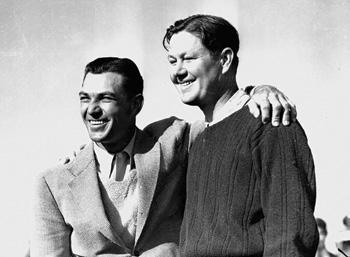
Running isn’t just for seasoned athletes—it’s an accessible way to move, start small, and surprise yourself.
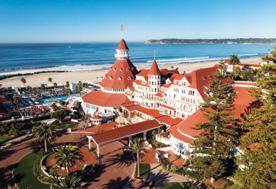
From passive income to long-term growth, today’s investors are finding smarter, modern ways to build wealth through real estate.
Buyers stand at a stylish crossroads—between the exhilaration of a sports car and the refined versatility of an SUV.
From corporate rainmaker to Mimik Essentials founder, Stephanie Klaproth turns reinvention into a blueprint with ASPIRE coaching.
Scottsdale’s Mountain Shadows brings a healthy dose of contemporary luxury to a street lined with old-school luxury resorts.
At the legendary Hotel del Coronado, history and glamour gather under the stars, where simple nightly rituals reveal the resort’s true magic.
PXG’s Battle Ready II Torpedo blends classic mallet stability with blade-like feel, redefining what a putter can deliver.
Fall style is less about adding more and more about shaping with intention—a season to edit, refine, and renew.

Golf gets easier when you stop chasing perfect positions and start swinging with the natural motion you already have.

As autumn arrives, Pinot Noir emerges as the season’s signature—elegant, versatile, and perfectly suited to fall’s table.
On the course, the right cigar turns a round of golf into a ritual—enhancing the pace, the mood, and the memory.
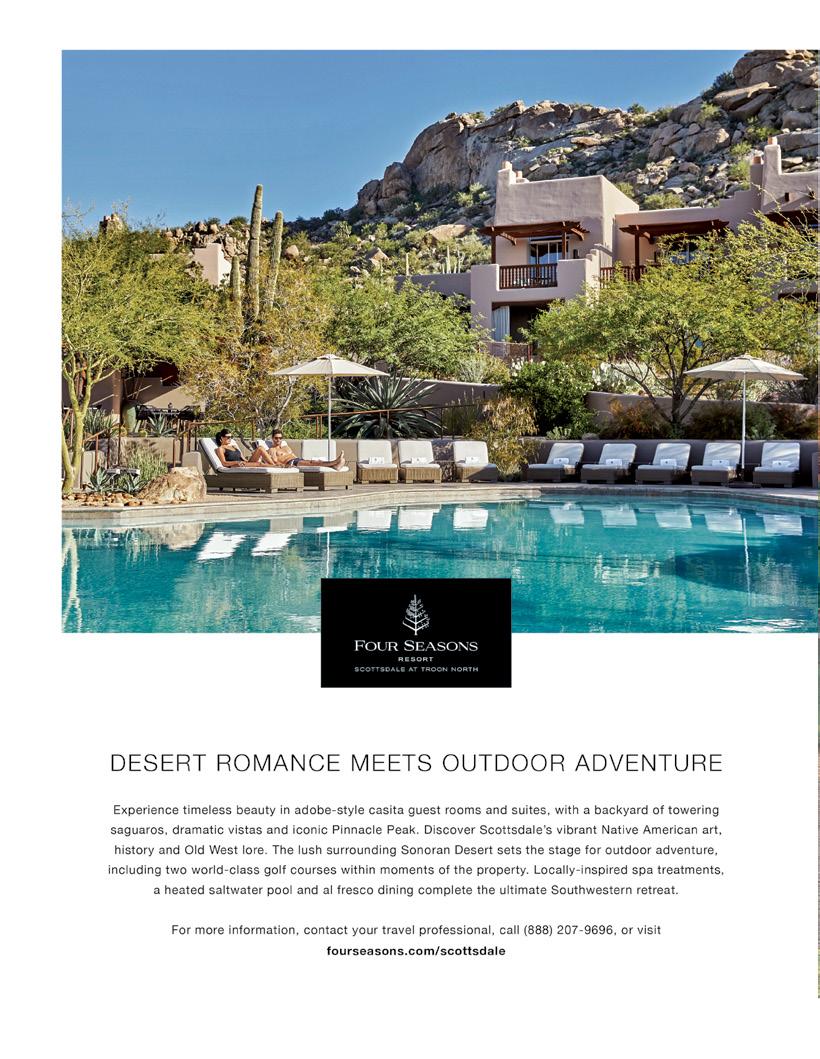

On a recent trip to Dallas, we were in the car—just two men talking. No real agenda. But before we reached the restaurant, the conversation turned into something much deeper—one of those un expected moments that stays with you.
I had shared with him a story from my past—about a man who once asked me directly, “Are you a believer?”
He was talking about religion, clearly. But I told him, “Yes, I’m a believer… but probably not in the way you mean.”
Because to me, belief is something bigger than doctrine. I believe in living by principle. I believe in honesty. I believe in purpose. I be lieve in treating people with dignity. That’s what I hold onto. That’s what guides me.
As we were headed to the restaurant, he leaned into the moment and shared something even more profound.
He began telling me about one of the hardest chapters in his professional life—how he had taken over a company that was bro ken from the inside out. The culture was toxic. The leadership had failed. And nearly everyone around him said it was a mistake. He was warned: Don’t touch it. Don’t do this.
But he moved forward anyway. Because he believed.
He told me that during those early days, it felt like walking through fire. The kind of fire that burns reputations, finances, rela tionships. And yet, he said, something his father had told him gave him peace. His father had looked him in the eye and said, “This will be the easiest thing you’ll ever do.”
That statement stayed with him. And in that fire, he felt shielded.
He referenced a story found in both the Bible and the Quran— the story of Abraham, who was thrown into the fire but wasn’t burned. Not because the fire wasn’t real. But because faith—belief— was stronger than the flames.
I sat there in the car, listening, fully drawn in. This wasn’t just a business story—it was spiritual. It was elemental.
And just as we finished circling the block looking for parking, right then—the best spot opened up. Front and center. Like it had been waiting for us. We both looked at each other and smiled. After all that conversation about belief and alignment… there it was. A small moment, but it felt cosmic. Perfect.
We went inside and sat down, and the conversation didn’t stop. In fact, it deepened. Over lunch, someone at the table said, “Let me ask everyone something: who have been your mentors?”
I was sitting on the right, so I went first. I named a few people who have shaped me—not just with their accomplishments, but with their time. With their presence. To me, a mentor isn’t someone you admire from afar. A real mentor brings you in. They take you under their wing. They walk with you, guide you, and show you how to move with purpose.
And what struck me was that everyone at the table had someone to name. People I admire—powerful, successful, accomplished— each had someone who poured into them. That reminded me that no one rises alone. Behind every strong leader is someone who be lieved in them first.
And that brings me to the road we’re all on.
If you’re going from Texas to California today, the route is simple. Just get on I‑10 and head west. But that’s not how my journey has looked. I didn’t have a clean, clear highway laid out in front of me. I had to cut through brush. I had to reroute. Double back. Get lost. Figure it out as I went. Some days I’ve felt more like Lewis and Clark than a businessman.
And I can tell you this:
This has been a summer of fire.
At times, the pressure has been immense. The doubts have been loud. The temperature—literal and figurative—has been high. But somehow, through it all, I haven’t felt burned. I’ve felt cool. I’ve felt protected. I’ve even felt joy.
That’s what belief is.
It’s not about being untouched by adversity—it’s about walk ing through it without losing yourself. It’s about keeping your compass pointed forward when everything around you tells you to quit.
So I’ll ask you the same question that once found its way to me:
Are you a believer?
Because when the belief is real—anchored, principled, and alive—everything begins to align.
Until next time,







PUBLISHER
PUBLISHER
Sedric Walker
Sedric Walker
ART DIRECTOR
EDITOR-IN-CHIEF
Leticia Galarza
Tony Dean
ART DIRECTOR
ADVERTISING
Leticia Galarza
Ornella Phillips
ASSOCIATE PUBLISHER
Natalie Kalbas
GOLF FEATURES EDITOR
GOLF FEATURES EDITOR
Carl Mickelson
Carl Mickelson
FEATURES EDITOR
FEATURES EDITOR
Richard Arebalo
Richard Arebalo
TEACHING PROFESSIONAL
TEACHING PROFESSIONAL
Buck Mayers
Buck Mayers
CONTENT SPECIALIST
Joel McColl
DIGITAL & SOCIALS
PHOTOGRAPHERS
Mario Rossi
Andon Guillory, Loui Shaya
PHOTOGRAPHY
CONTRIBUTING WRITERS
Spencer Roth
Michelle Keller, Leslie Stevenson, Art Stricklin, Tara Lee Maloney
CONTRIBUTING WRITERS
Teresa K. Traverse, Tony Dean, Gustavo Román Jr, Tifanny Roth, Mona Joon, Marc Hall
INTERNET & DIGITAL
Alexandria Moya, Karen Kreeps
OTL magazine is published bi-monthly by Pristine Media, Inc. Executive, editorial,and advertising offices are located at 210 Grand Isle Drive. Round Rock, TX 78665. Advertising rates furnished upon request. Advertisers warrant and represent that the
OTL Magazine is published bi-monthly by Pristine Media, Inc. Executive, editorial,and advertising offices are located in Round Rock, Texas. Advertising rates furnished upon request. Advertisers warrant and represent that the descriptions and depictions of the products or services advertised are true in all respects. All advertising is subject to approval before acceptance. OTL reserves the right to refuse any ad for anyreason whatsoever. ©2025 by OTL. All rights reserved throughout the world. Reproduction in whole or part without the express written consent of OTL is strictly prohibited. Editorial queries and manuscripts should be directed to the editor via email, editor@otlgolf.com. All letters and their contents sent to OTL are sole property of OTL and may be used, printed, and published in any matter whatsoever without limit, obligation and liability to the author thereof. All views expressed in all articles are those of the authors and artists and not necessarily those of OTL or its advertisers. Manuscripts should be accompanied by self-addressed, stamped envelopes. OTL assumes no responsibility or liability for the return of unsolicited artwork, manuscripts or pictures. Printed in the USA.

STORY BY KATIE SOLTAS
When travelers typically picture trips to the islands of Tahiti and Bora Bora, honeymoon occasions often come to mind. With its turquoise central lagoon, Mount Otemanu’s lush green slopes as a dramatic backdrop and an assortment of resorts featuring overwater bungalows, the island is practically engineered for secluded romance.


ut what if you changed your perspective?
There is plenty of ex ploration, elevated re laxation and culinary adventures to be had by everyone in Bora Bora – newlywed status not required. After the arduous year we’ve had, why not take your “re venge travel” trip to the South Pa cific? Whether it’s a father-son trip, a girlfriend getaway or a delayed re treat with your significant other, this tropical paradise may be the perfect setting to rejuvenate and reset.


Although Bora Bora is located in French Poly nesia, one of the most isolated island chains in the world, it’s easier to get to than you may real ize. For Texans, the flight time is comparable to jetting over to Europe – between 12 to 15 hours with one stop on the West Coast.
After flying into the main island of Tahiti and its capital city, Papeete, you’ll be greeted with a
warm “Ia Orana” from the locals, Tahitian for “hello.” Stop by the Papeete market to pick up some Tahitian pearls and jewelry souvenirs.
From there, it’s a quick 50-minute flight to Bora Bora and its white sand beaches on the palm covered motu, an atoll created by volcanic rock and coral reef, that houses most of the ma jor resorts.

There are two luxury options to visit for an idyllic French Polynesian escape: Four Seasons Resort Bora Bora and St. Regis Bora Bora. Four Seasons prides it self on the cultural immersion its guests experience, combined with the highest standards of service through the gracious hospitality of Polynesia. The beachfront resort, which recently underwent a prop erty wide enhancement in 2020, offers 108 overwater bungalow suites and seven beachfront villa estates, all designed with thatched roofs and native artwork. An upgrade to an estate secures you a pre arrival planning consultation, round trip airport transfers, a dedicated Villa Host, private beach set up with watersports equipment and a private bar stocking.
While most of the motu’s resorts naturally embrace ocean activities with the prime lagoon location, Four Seasons goes a step further and has added jungle safaris to explore the surrounding area and indigenous wildlife. Beneath the surface, guests are welcome to snorkel and explore the Lagoon Sanctuary, which serves as an active research and conservation facility with more than 100 colorful marine life creatures.
Other provided activities include an onsite dive center to organize begin ner to advanced scuba opportunities around and outside the lagoon, hiking excursions on the main island including to Mount Otemanu and Mount Pahia as well as an array of watersports such as outrigger canoe paddling.
After a day of excursions or per haps a leisurely morning lounging on a private cabana deck, guests can find reprieve in the Te Mahana Spa capturing surging, where raw power of the ocean meets the lagoon’s tran quility. The full service spa features walkways elevated above the treetops on the motu’s summit and a glass bot tom treatment suite, with services that incorporate Polynesian customs and healing herbs like the Kahia Flower, Monoi Oil to naturally enhance and bring out skin’s youthfulness and parau, or black pearl powder, for its exfoliation and revitalization.



With 90 rooms comprised of charming garden view vil las, beachside villas and the largest overwater bungalows in Bora Bora, St. Regis has accommodations to please ev ery visitor to French Polynesia.
Upgrade your stay by booking the Royal Estate Villa, a 13,000 square foot compound with a private beach and pool showcasing tropical lagoon views, three bedrooms, a professional kitchen, spacious common areas and a master bedroom pavilion with a sauna, whirlpool and steam room. And let’s not forget the legendary butler service, personal yoga instructors and private chefs available at St. Regis.
From its Iridium Spa to group yoga sessions around the property, all activities encourage guests to take in the panoramic views of the Lagoonarium and Mount Otemanu while focusing on “calm contemplation.”
For those who can’t get away from the daily grind, St. Regis invites you to set up office in Bora Bora to work re motely from paradise with a Zoom background that will be the envy of your colleagues. Perks include a nightly three course dinner, an “IT Butler” to help you stay connected in ternationally, a kids club to keep the little ones entertained while you work and more.
Iridium Spa occupies its own island in the middle of the lagoon, so guests are surrounded by calming shades of blue. The spa offers a fusion of treatments from Polynesian and Asian cultures using a variety of rejuvenating thera peutic methods and sophisticated plant science.
St. Regis also has its own lagoonarium so you can snorkel and dive with the marine life without leaving the resort. Truly an undersea ecosystem, the Magical Lagoon arium is a thriving coral and fish preservation area with more than 120 species of fish including sting rays,10,000 coral colonies and 5,000 varieties of clams to observe.
With 90 rooms comprised of charm ing garden view villas, beachside villas and the largest overwater bungalows in Bora Bora, St. Regis has accommoda tions to please every visitor to French Polynesia.
Upgrade your stay by booking the Royal Estate Villa, a 13,000 square foot compound with a private beach and pool showcasing tropical lagoon views, three bedrooms, a professional kitchen, spa cious common areas and a master bed room pavilion with a sauna, whirlpool and steam room. And let’s not forget the legendary butler service, personal yoga instructors and private chefs available at St. Regis.
Guests have the opportunity to help with the “reforesta tion of coral reefs” by partnering up with the lagoonarium’s marine biologist to regenerate the reefs. Advanced divers and snorkelers may work with the activities concierge to arrange other excursions off the resort, such as swimming with lemon head sharks, sting rays and other amazing sea life in deeper areas of the lagoon and ocean.
“Our Lagoonarium is a natural wonder that you won’t find anywhere else in the region,” said General Manager, Emmanuel Richardet. “We are proud of the work being done to preserve and protect this sustainable ecosystem and are grateful for our Marine Life Specialist’s passion and expertise. Our guests enjoy the coral plantings and fish feedings because they get to learn while helping to ensure that the Lagoonarium continues to thrive.”

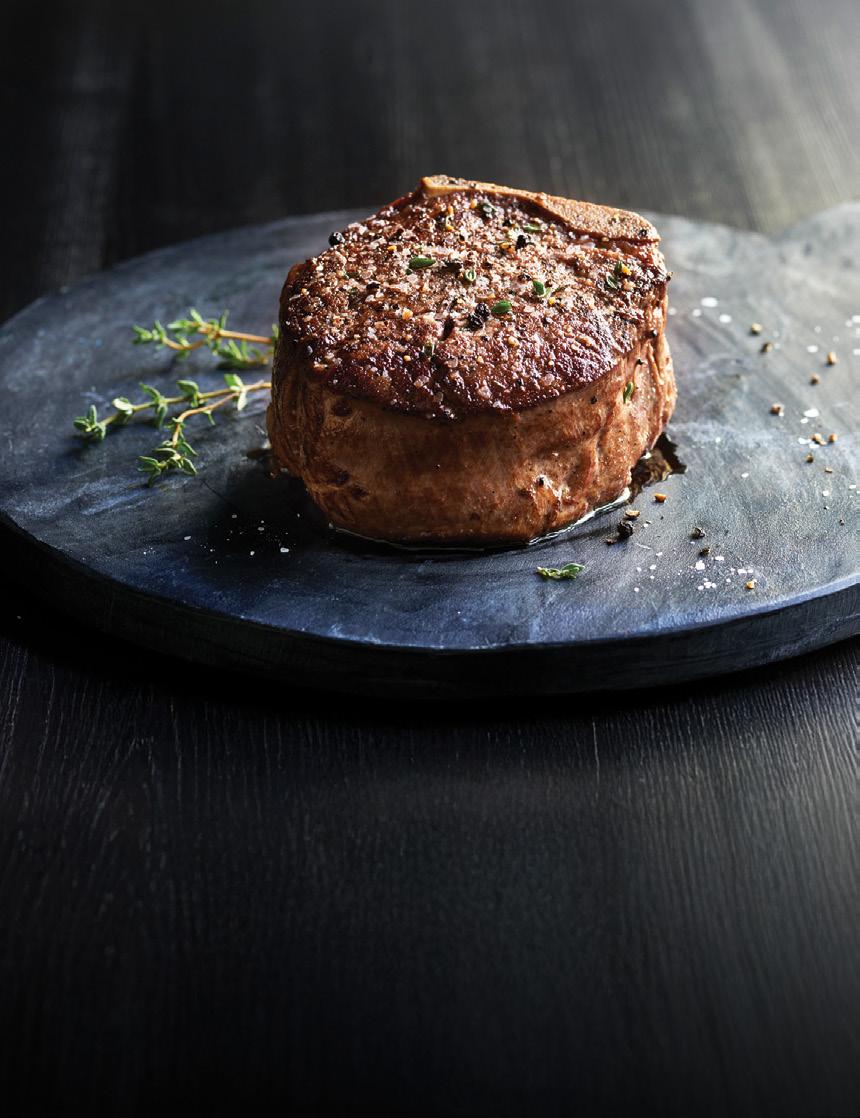
STORY BY GUSTAVO ROMÁN JR., RRCA CERTIFIED RUNNING COACH & OWNER OF TAVO COACHING
If you’ve ever looked at runners cruising down the roads and thought, “I could never do that,” I’m here to tell you that you can.
Running is one of the most approachable forms of movement out there. You don’t need fancy gear or perfect form. You just need a body (any body), a safe place to move, and a willingness to start small.
Try walk run intervals. Start by alter nating one minute of running with one or two minutes of walking. Do that for about 20 minutes total two or three times a week and you’ve already built a strong founda tion. From there, add a little more running each week. The key is showing up consis tently, not pushing yourself to exhaustion.
You don’t need to buy anything special to get started. A basic watch with a timer works great, or you can use your
phone and one of the many free GPS apps if you’d like to track your time and distance. Lightweight, breathable clothes are ideal, but whatever you already have and feel comfortable in is a perfect place to start. If you already own running-specific shoes, great. If not, wear what feels good on your feet and adjust later. Every new thing you buy should be seen as a tool to make run ning simpler or more comfortable—not a requirement to be taken seriously.
A few common myths come up often. One is, “I have to go fast.” Not true. Most runners at every level of experi ence actually run too hard. Slow it down to a pace where you can speak in full sentences. An



other myth is, “I’m not a real runner.” If you run, you’re a runner. Speed and distance have nothing to do with it.
It can be a workout, a break from your screen, a mental reset, or a way to build confidence. You get to decide what role it plays in your life. There’s no one way to do it right.
If you’ve been waiting for a sign, this is it. Lace up, step outside, and start with a few minutes. You might be surprised by what you’re capable of.
Gustavo Román Jr. is the owner of Tavo Coaching, where he works with athletes training for everything from their first mile to their twentieth ultramarathon. He believes running should meet you where you are, not where you think you should be. His wife, Cathy Román, is an NASM Certified Sports Nutrition Coach and helps tailor each athlete’s fueling strategy. As an athlete, Gustavo has raced the Boston Marathon twice, finishing in the top 1,000, and is currently training for his second World Marathon Major in Berlin this fall. He holds personal bests of 2:38 in the marathon and 1:12 in the half marathon.
@tavocoaching @gustavoromanjr run@tavocoaching.com tavocoaching.com

For many affluent investors, real estate remains a cornerstone of a diversified portfolio. But as the market evolves, so do the ways people are choosing to invest. Whether you’re looking for passive income, longterm appreciation, or simply a smarter way to own property, there are a few modern strategies worth considering.

High end vacation homes in scenic or re sort style locations can offer lifestyle perks and income potential. Some buyers are using their second homes as short term rentals during off seasons to offset carrying costs. While this can be lucrative, it’s not without drawbacks. Managing a property—even with a service—re quires attention, and local regulations on short term rentals are tightening in many markets.
For those who want the experience of own ing a vacation home without the full respon sibility or year round commitment, fractional ownership has become an increasingly popular model. Companies now offer curated shares of high end properties with professional manage ment and scheduled usage. It’s a more hands off way to enjoy luxury real estate, though it comes with limitations on control and resale flexibility.
Real Estate Investment Trusts (REITs) of fer exposure to real estate markets without the demands of direct ownership. Publicly traded REITs, in particular, can be bought and sold like stocks, making them accessible and liquid. While returns may vary with market cycles, many investors use REITs for steady dividends and long term growth potential. As with any in vestment, due diligence is key.
Each of these strategies comes with its own benefits and trade-offs. The right approach often depends on your goals—whether they lean more toward lifestyle enjoyment, passive income, or long term appreciation. Speaking with a qualified financial or real estate advisor can help determine the strategy that aligns best with your broader wealth plan.
In today’s environment, owning property no longer has to mean doing it the old fashioned way. With smart planning, real estate can still be one of the most rewarding investments— both financially and personally.
Let me know if you want a version for layout with subheadings bolded or adjusted.
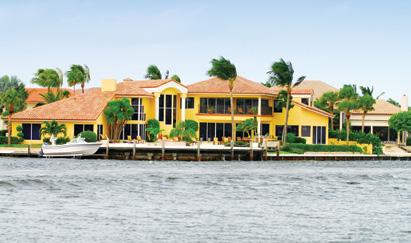

STORY BY GRAHAM WHITFIELD
How your fall ride reflects your lifestyle choices

Fall brings a shift in mood and mo mentum. The heat of summer gives way to crisp mornings, golden leaves, and weekends filled with football games, vineyard tours, and cozy getaways. It’s also the perfect season to think about your next vehicle. Many luxury buyers find themselves at a stylish crossroads: do you embrace the thrill of a sleek sports car or the all season versatility of a luxury SUV?
A sports car is more than just fast— it’s an expression of freedom. A Porsche 911, Jaguar F Type, or even a classic Mustang convertible can turn an ordi nary commute into an experience. It’s the ultimate personal statement: bold, refined, and a little indulgent.
Pros:
• Sleek, eye catching design
• High performance handling
• Ideal for solo drives or date nights
• A symbol of success and personal expression
Cons:
•Limited seating and cargo space
• Often impractical for family or group travel
• Less suited for long road trips or rough terrain
Luxury SUVs thrive in the fall season, where comfort and capability are key. Whether it’s a weekend
drive to admire fall foliage, tailgating in style, or managing family duty, models like the Range Rover, Mercedes Benz GLS, or BMW X7 deliver both luxury and practicality.
Pros:
• Spacious interiors with high end comfort
• More flexible for families, travel, or gear
• Elevated driving position and all weather capability
• Often equipped with advanced tech and safety features
Cons:
• Lower fuel efficiency
• Less sporty or nimble than coupes or convertibles
• Can feel oversized for solo or ur ban drivers
That depends on your lifestyle. Emp ty nesters might indulge in a two seater just because they can. Families juggling school schedules and weekend escapes may prefer the practicality of an SUV. And some drivers opt for performance crossovers that blend speed, capability, and family friendly flexibility.
Whatever you choose, remember: your fall vehicle isn’t just transporta tion—it’s part of the season’s journey. And with autumn’s crisp air and scenic drives ahead, the open road is yours to explore.




STORY BY TERESA K. TRAVERSE
he Arizona Biltmore is one of Phoenix’s most storied resorts. The iconic property opened on Feb. 23, 1929, and visitors can feel that history even a century later. The hotel’s archi tecture is a great example of the Art Deco style that was popular at the time. The Biltmore also became a des tination for celebrities of that era like Clark Gable, Frank Sinatra and Marilyn Monroe. Bartender Gene Sulit came up with the classic tequila sunrise cocktail here in the 1930s. Many presidents have also spent the night here. Flash forward to the present, and the resort is con stantly innovating to keep up with the times while staying true to its historical roots. The property unveiled a sweep ing, property wide renovation that was finished in 2023. Part of that addition included Latin inspired restaurant Re nata’s Hearth.


In keeping with the resort’s truly ex clusive feel, the Arizona Biltmore is the only hotel in the Grand Canyon state that is hosting Le Petit Chef. Le Petit Chef is a projection mapping dining experience that’s available this summer as a way to give guests a fun way to stay out of the heat and enjoy the great indoors. Projec tion mapping is a way of, you guessed it, projecting videos on flat surfaces—like a table—and can be used to create 3D im ages. If you’ve never seen projection map ping before, it’s well worth it. The projec tions, provided they’re done well, look dreamy and even magical.
Le Petit Chef’s projection mapping in volves a 6 centimeter tall French chef who creates each individual plate. Tucked away in a private dining room just off the lobby and a few steps from Renata’s Hearth, Le Pe tit Chef plays out across white plates that are in a dimly lit room. The space’s long table can seat up to 18 was illuminated with an image of a chef complete with a white toque in a greenhouse surrounded by plenty of green grass seemingly preparing our first course of burrata and Duncan Farm beets. A small butterfly landed on the plate and flapped his wings before flying off. The chef was watering the grounds and wheeled out
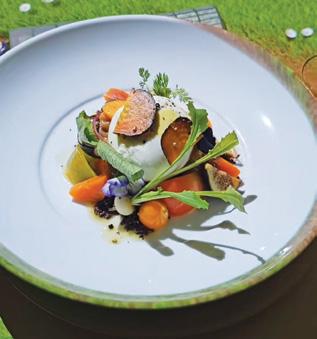
the creamy burrata onto the plate. This light plate also featured heirloom tomatoes that complemented the creamy cheese, arugula, gooseberry and apple—the entire plate was a colorful mix of ingredients.
Next up was the seared Mediterranean seabass course. The projection showed the chef circling around the perimeter of a white plate with the sea all around him and pull ing in his fresh catch. He also rode a jet ski in the water and was eventually captured by a long tentacle of an octopus before be ing dropped into the plate of soup. Lobster, sourdough and leeks accompanied the flaky and tender seabass in a shellfish nage broth with a rouille sauce.
After the fish course, we enjoyed a slice of American wagyu. The tender meat was served with asparagus, ribbons of carrot, Yukon potato and a few dollops of Dijon hollandaise.
The entire experience concluded with Meyer lemon crème brulee. The projection before the final course showed the chef pouring cream into a gold, circular plate as he prepared the dessert with various spices that took the shapes of animals like a tiger, a camel and a dragon that all seemingly evap



orated into thin air. To finish, the chef lit a match and then bruleed the sugar to finish before disappearing. Perhaps our favorite presentation of the evening, this course featured crème brulee served in a large white plate with a deep circle in the center that was dressed up with colorful fruit like bright red strawberries and dark blackberries on the arch of the plate above the classic French dessert. We cracked into the crispy crème bru lee crust for a truly decadent, yet light delight. Its sweetness was tempered by the tart lemon. Finally, the experience wrapped up by featuring fireworks on the table followed by sparkles surround ing the white plate—making for one magical conclusion.

The projections were accompanied by themed music. For instance, the crème brulee video featured Asian music when the chef add ed the spices. The entire experience was whim sical and captivating. Given that it really is a true dinner and a show experience, it makes total sense that Le Petit Chef is also geared to ward children ages six to 12. The junior menu features crispy burrata to start, followed by a tomato bisque served with sourdough grilled cheese, sweet shrimp and heirloom vegetables fried in tempura batter and served with soy broth and black garlic aioli. The kid’s course is finished with the same dessert as the adult menu, the crème brulee.

Vegetarian diners also can order a specialty menu tailored to them. This menu kicks off with the burrata and beets course, which is then followed by braised leeks served with ar tichoke, heirloom tomato, marble potato and sourdough served in a rouille sauce. The main course is a decadent mushroom risotto featur ing market harvest mushrooms, Parmigiano Reggiano fondue, maple garlic and marsala. The vegetarian menu also finishes with the crème brulee.
Le Petit Chef seatings are between 90 min utes to two hours long. The dress code is resort casual, but flip flops, shorts and tank tops are not allowed. Le Grand Chef tasting menu costs $195 per person plus tax and service charge. Visit lepetitchef.com/phoenix for more infor mation.
Above all, we found the experience to be a refreshing mix of modernity coupled with the Biltmore’s deep historical roots. The Biltmore’s collaboration is yet another example of the re sort’s commitment to excellence.
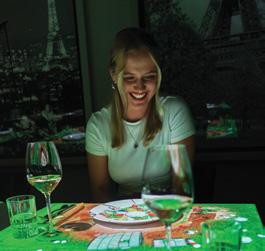

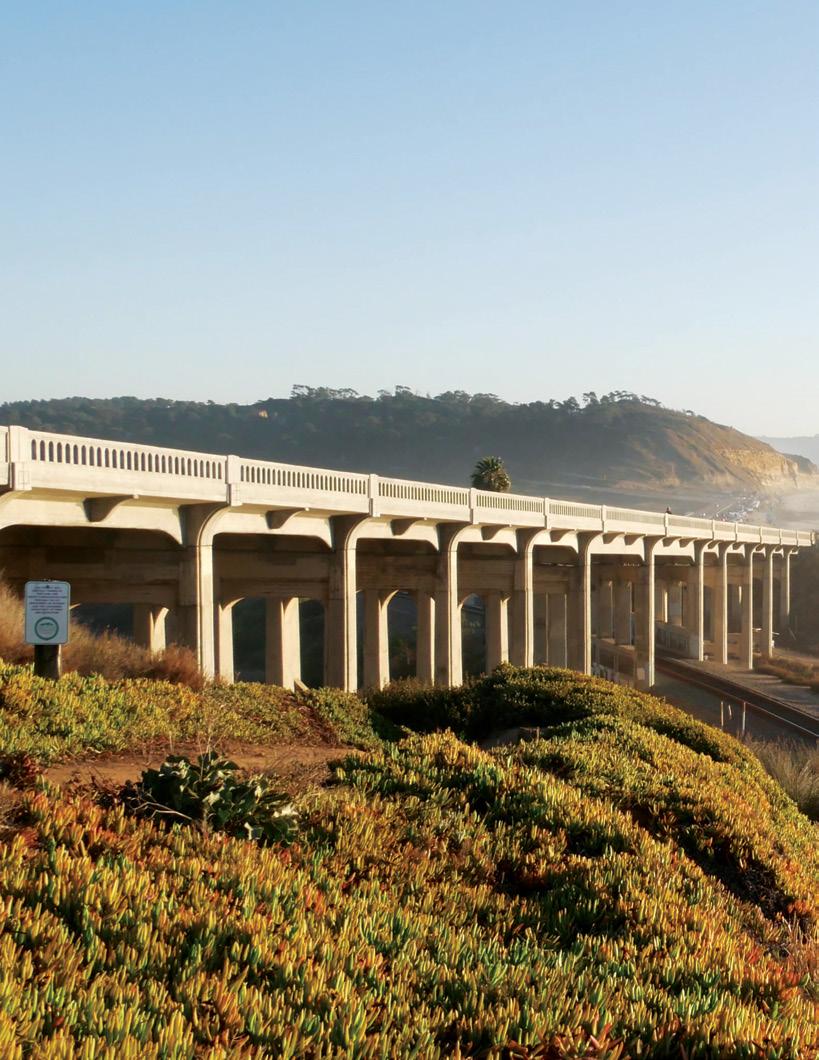
Freedom, connection, and the rediscovered beauty of the open road
STORY BY GENE GREEN
There’s a hum that comes just before the highway opens up—a feeling, more than a sound. Maybe it’s the low thrum of tires on pavement, or the soft click as the cruise control sets. But what it really is… is freedom.
This fall, luxury travelers are rediscovering that freedom doesn’t always come from a boarding pass. Sometimes, it’s waiting at the end of your driveway, parked and ready to go. The road trip is back—and it’s never looked better.



In a culture that worships speed—fast food, fast streaming, fast flights—the road trip offers something radical: a chance to slow down. There’s no TSA line, no frantic gate change, no cramped middle seat. There’s just the horizon ahead, crisp autumn air, and the people you’ve chosen to bring along.
“The best way to get to know someone is to travel with them,” said Samuel Clemens (better known as Mark Twain). It’s a sentiment that feels especially true now. In a luxury SUV or refined touring vehicle, time on the road becomes time to connect—not just with companions, but with yourself.



This isn’t your grandfather’s station wagon with vinyl seats and paper maps. Today’s luxury SUVs—from the Escalade and Range Rover to the Mercedes GLS and BMW X7—are built for long drives and long weekends. Think heated and ventilated seats, soft close doors, premium sound systems, and interiors de signed to feel more like boutique hotels than cabins on wheels.
For couples, smaller but no less luxurious crossovers and se dans offer the same refinement with a more nimble footprint— perfect for winding scenic drives through mountains, vineyards, and small town main streets glowing with fall color.
Where you go matters less than how you feel on the way. Some families head to Yellowstone or Zion to enjoy the cooler weather. Others explore Arizona’s Verde Valley, road tripping from Sedo na’s red rocks to Flagstaff’s pine covered peaks. Romance seekers find their way to a cliffside resort along California’s Pacific Coast Highway, or a vineyard in the Texas Hill Country during harvest season.
And for those chasing fall’s most iconic views? Vermont’s Route 100 and the Blue Ridge Parkway are unmatched—rolling hillsides painted in red, gold, and orange.
Luxury motorhomes are also having a moment. High end RVs now feature gourmet kitchens, rainfall showers, and Italian leath er seating. It’s five-star travel—without the nightly check-in.

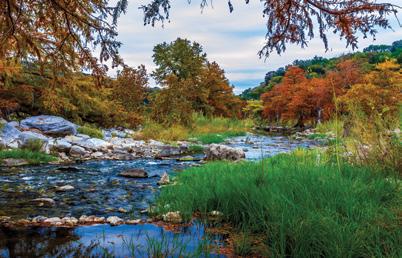
• Vermont’s Route 100 – The ultimate foliage drive, weaving through small towns, covered bridges, and rolling farmland.
• Blue Ridge Parkway (NC/VA) – A winding mountain route with endless overlooks and vibrant fall colors.
• Colorado’s Million Dollar Highway – Jagged peaks and alpine valleys drenched in gold aspen groves.
• Lake Tahoe Loop (NV/CA) – Crystal waters framed by snow dust ed peaks and fiery yellow aspens.
• Texas Hill Country Wine Roads – Outside Fredericksburg, enjoy vineyard harvests, rustic ranches, and small town charm.
It’s not just the convenience of road travel that’s fueling this trend—it’s the emotion. We live in a time where everything is optimized, filtered, and over-planned. But the road? The road allows for wonder.
You might stop at a roadside stand selling fresh cider. You might pull over to take in a hillside blazing with maples at peak color. You might, for the first time in a while, feel unhur ried.
There’s something romantic about that. Something nostalgic and new at once.

• “On The Road Again” Willie Nelson
• “Zoom” – Commodores
• “Harvest Moon” – Neil Young
• “September” – Earth, Wind & Fire
• “Life is a Highway” – Tom Cochrane
• Levitating – Dua Lipa
Gourmet Snacks
• Dark chocolate–covered almonds
• Artisan cheese + crackers
• Fresh apple cider or sparkling water
• Seasonal fruit (grapes, figs, apples)
• Charcuterie to go: prosciutto, salami, olives

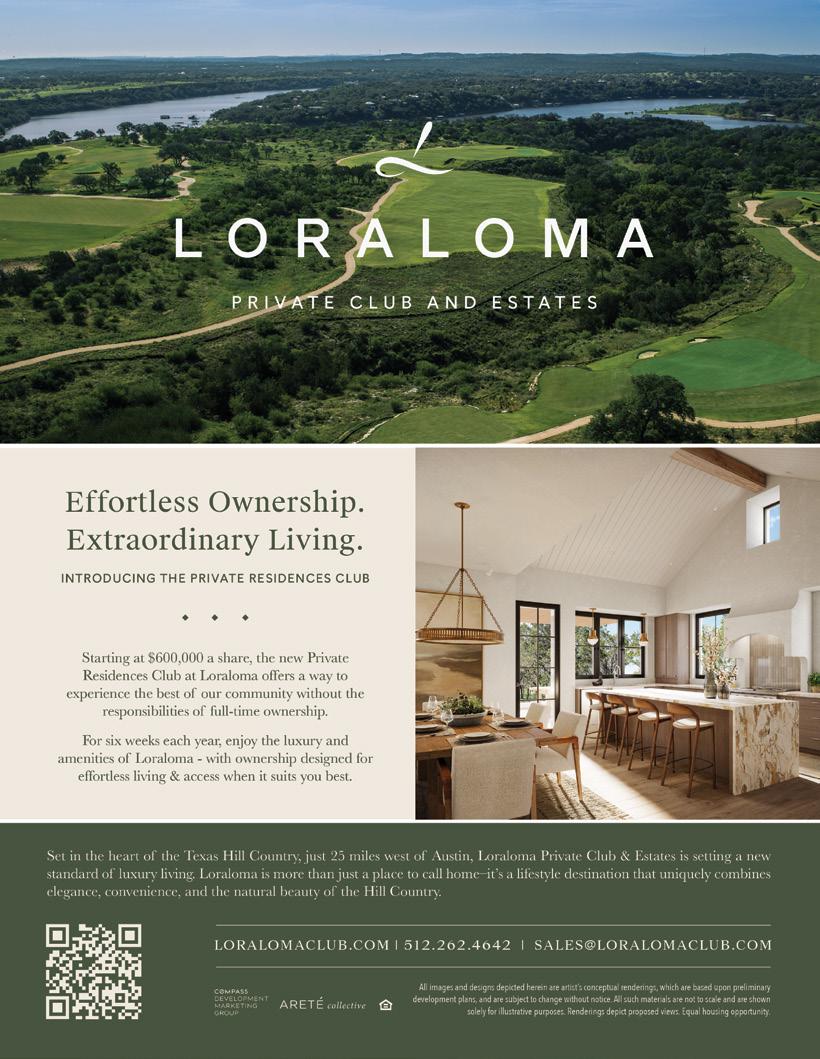

STORY BY TONY DEAN
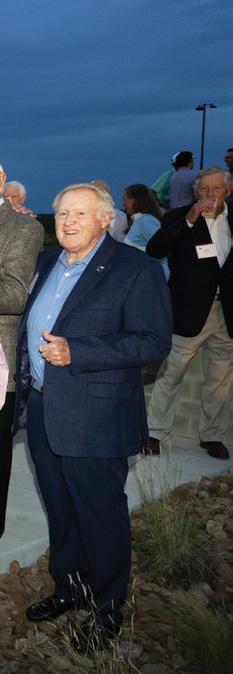

In Texas, golf isn’t just a pastime. It’s a deeply rooted tradition, rich with stories, personalities, and a quiet reverence for those who’ve shaped the game. That tradition finds its most enduring home in the Texas Golf Hall of Fame—a living monument that honors champions, teachers, and the courses that built them.
What began as a vision to preserve the state’s storied golf legacy has become a growing movement—one that honors not only greatness, but character, commitment, and community.
Physically, the Hall main tains a visible footprint across Texas—from its Walk of Fame at Brackenridge Park Golf Course in San Antonio, to its newly es tablished site at PGA Frisco on the Northern Texas PGA campus. These sites offer a tactile connection to the past, where visitors can walk among plaques and monuments dedicated to the giants of Texas golf.
But perhaps the most groundbreaking develop ment is digital. Through an expansive online museum at www.texasgolfhof.org, the Hall has created an immer sive, cinematic experience that brings golf history to life. Each inductee’s story is captured through film, pho tos, memorabilia, and per
sonal artifacts—accessible to fans not just in Texas, but around the world.
“We’re putting the en tire history of Texas golf in the palm of your hand,” says Chairman Mike Booker, himself a Hall of Fame in ductee and champion ama teur. “This is about preserv ing something sacred—and making it accessible for gen erations to come.”
Executive Director Alli Jarrett emphasizes the im portance of this hybrid ap proach. “Our Digital Mu seum is ‘living’—we can continuously update exhib its as our members achieve new milestones,” she says. “We’re honoring the past, celebrating the present, and inspiring the future.”
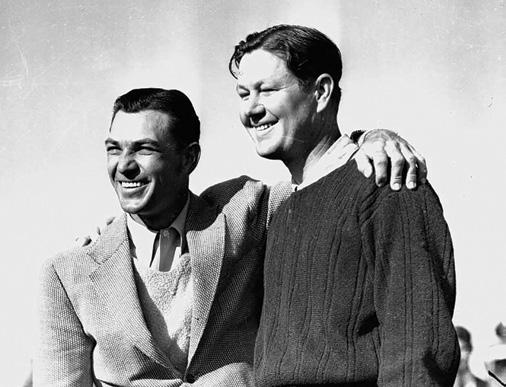




Harvey Penick.

The Texas Golf Hall of Fame includes 156 in dividual members and 15 Historic Golf Courses— each elected for their impact on the game, their influence in the community, and their legacy both on and off the course.
From Ben Hogan’s steely precision to Babe Didrikson Zaharias’ unmatched athleticism… from Harvey Penick’s quiet wisdom to Tom Kite’s and Ben Crenshaw’s major victories—the Hall brings these stories together in one unified voice.
Other legends include Sandra Palmer, Angela
Stanford, Jackie Burke, Judy Rankin, Lee Elder, Kathy Whitworth, Sandra Haynie, Lee Trevino, and Charles Coody, among others. Builders of the game like Verne Lundquist, Barney Adams, Marvin Leonard, and Randy Smith are also rec ognized—not just for what they did, but for how they moved the game forward.
The Hall’s Registry of Historic Courses ensures that physical spaces like Champions Golf Club, Houston Country Club, Colonial Country Club, Oak Hills, and Austin Country Club are remem bered alongside the players who made them hal lowed ground.
On October 22, 2025, the Texas Golf Hall of Fame will host an unforgettable evening at the prestigious Austin Country Club. This special trib ute will celebrate the life and legacy of Harvey Penick, one of golf’s most beloved instructors, whose teachings helped shape generations of champions.
The evening will honor Penick through three of his most celebrated students—Ben Crenshaw, Tom Kite, and Sandra Palmer—each of whom car
ried Penick’s wisdom onto the world’s greatest stages. The event promises not just ceremony, but heartfelt remembrance, reflection, and reverence for a mentor whose influence lives on in every swing taken with grace and integrity.
Tickets are still available for this landmark occasion, offering golf lovers a rare opportunity to witness and participate in a moment of true historical significance.
What makes the Texas Golf Hall of Fame special is not just who it honors—it’s how. The Hall’s vision is bold: to become the most respected regional golf Hall of Fame in the country. Through a $5 million endowment campaign, part nerships with the Texas Golf Association, PGA Sections, CMAA, GCSA, Alamo City Golf Trail, and Veritex Communi ty Bank, and ongoing digital storytelling, it’s a mission that is well underway.
One of the Hall’s most ambitious and meaningful proj ects is its state of the art digital museum, which brings in ductee stories to life with rich video, historical archives, and immersive exhibits. To date, 57 of the 156 inductees and 5 of the 15 Registry courses have been digitally captured.
The work continues, supported by donors who recognize the value of preserving these legacies.
Each exhibit is more than biography; it’s a celebration of character, community, and the timeless spirit of golf in Texas.
Jarrett notes that she still gets goosebumps revisiting certain stories. “I’m continually inspired by our members,” she says. “Beyond 102 major championship wins, 25 World Golf Hall of Fame members, and nearly 1,000 PGA/LPGA Tour victories, I’m most proud of their military service and lasting contributions to society. Who would have imagined that Dr. Marvin Ferguson’s USGA green construction method would not only transform golf but also shape today’s athletic fields—from soccer to baseball?”
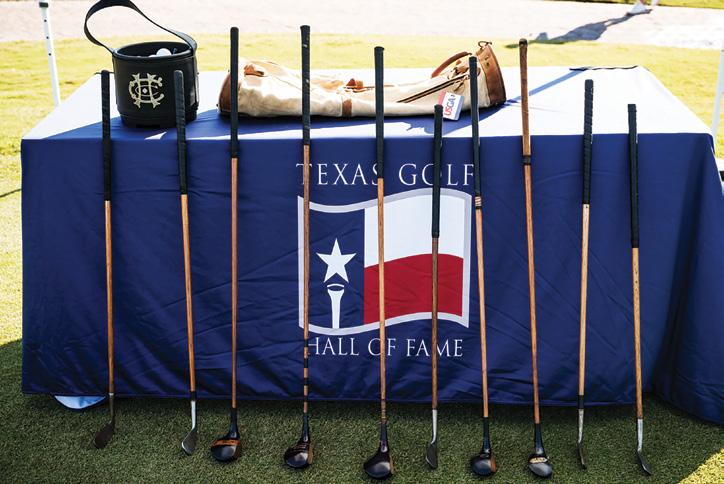
In today’s fast moving digital age, the stories of the past risk being left behind. The Texas Golf Hall of Fame stands as a cultural anchor—not just for golf fans, but for anyone who values tradition, mentorship, and excellence. It connects generations, reminding young athletes that the game is as much about respect and integrity as it is about birdies and trophies.
Supporting the Hall isn’t just about nostalgia—it’s about ensuring that the next generation of golfers under stands the shoulders they stand on. It’s about providing role models who reflect not just sporting excellence, but class, humility, and heart.
Jarrett hopes that young visitors walk away not only with inspiration but with a broadened sense of what’s possible. “The Hall includes athletes, inventors, engi neers, architects, broadcasters, coaches, and business leaders,” she says. “By sharing their stories, we hope to inspire youth to pursue their passions through the game.”
The Hall also plays a vital role in growing the game, with outreach programs that promote youth golf, charac ter education, and access to historical storytelling that in spires young minds. As golf evolves, the Texas Golf Hall of Fame ensures that its roots grow even deeper.
Whether you’re a lifelong Texan, a weekend golfer, or simply someone who appreciates the values the game rep resents, the Texas Golf Hall of Fame is worth your time.
Visit it online. Walk its paths in San Antonio. Explore its archives. Attend its events. Share its stories.
Because when you support the Texas Golf Hall of Fame, you’re not just backing an institution. You’re helping write
the next chapter in a story that belongs to all of us.
If you want to be part of that next chapter, consider joining the Circle of Eagles—a membership community that helps sustain the Hall’s mission and outreach pro grams. Members receive unique benefits and recognition, and most importantly, become part of something larger than themselves. Visit www.texasgolfhof.org to learn more about how to get involved.






From humbling views atop mountain trails to rapturous cotton candy sunsets over jagged peaks, there are so many things in the Valley of the Sun that one simply must experience firsthand. Given my shamefully narrow world view, though, so many of those things happen to involve either golf, art, nature, food or additivefree tequila. And, I might be embellishing on a few of those, because, mostly the things I like witnessing for myself these days involve a small white ball against the canvas of a rich blue sky and a sea of grassy green.
he biggest mystery in my mind when it comes to the Scottsdale golf scene involves Talking Stick Golf Club, a property that is home not one, but two golf courses designed by the legendary duo Bill Coore and Ben Crenshaw – The O’odham and Piipash courses (formerly dubbed the North and the South). So many of the designs in this estimable team’s portfo lio are modern masterpieces. Increasingly, Coore and Crenshaw are becoming not just a prevalent presence on every Top 100 Golf Course list, but a dominant one.
So, what this easily distracted golf addict from Texas has long wondered is ‘Why isn’t Talking Stick mentioned in the same breath with other destinations where standout Coore Crenshaw creations call home, places like Bandon Dunes, Streamsong or Kapalua?’ Are there glimpses of the creative artistry you’d see at Friar’s Head, Cabot Cliffs, or even We Ko Pa? In a golfing mecca like Scottsdale, shouldn’t the place with a pair of presumed Rembrandts be the talk of the town? Hav ing queried golf writers, course raters and a couple of dozen 50 round a year diehard locals, O’odham is repeatedly called finely maintained but a touch uninspiring. In truth, Coore and Crenshaw have set the bar high with so many of their designs, it’s unfair to assume they’ll all look and play like Ryder Cup venues. Nevertheless, being so enamored with so much in the C and C portfolio, I had to get over to Talking Stick and make my own (however inconsequential judgments.
What I liked about this golf course instantly is that it gets you off and running easily. Good for pace of play. Good for scor ing. The first hole is an open 394-yard par four that swings gen tly from right to left. A mid iron approach to a wobbly pancake green is all you need to shake those early round jitters. The sec ond hole is equally generous off the tee. The ample par five plays to a spread them out yardage of 552 yards. These two early scor ing opportunities are a refreshing respite from some of the white knuckle target golf rounds I’d played earlier in the week.
The ample landing areas off the tee I can be regarded in the number of ways. I instantly thought of pure Scottish link style golf in the mold of the Old Course at St. Andrews. There, you will not mistake wide and generally flat topography with easy or overly simple golf. Savvy golfers know that certain por tions of the fairways on the course will feature speed slots that generate more roll out if you play drives on the appropriate line. Generous fairways also lend to keen strategy in setting up approach shots. On a smart design like this, there’s always going to be a good, better or best way to angle in your second or third shots from the fairway.
The fifth hole is a great example of this. I got a little extra on my left favoring tee shot and a speed slot got me an extra 30 to 40 yards past my paying partners. I’d like to tell you I converted the birdie putt after a gap wedge approach. I mean, I’d like to tell you that…
The sixth is a 200 yard par 3 that’s nicely framed by native desert vegetation and with a green protected by sand traps on either side of the green.
The character of this golf course really starts to kick in on the second nine. After a lengthy par four and a long par three you reach the clever par for 12th. It’s this hole, perhaps more than any other on the course, that reveals the stunning potential this golf course has to challenge, intrigue and delight golfers with creativity as well as temptation. Rocky wash (we might





call it a dry creek bed back in Texas) splits the fairway down the middle, allowing golfers to choose a straight forward but narrow path down the left side that affords a short approach into the green or a conservative poke down the more generous right side that leaves a slightly longer approach that still miss carry the wash. It’s a fun hole and one of the best on the course.
At this point in the round we’re basically as far from the clubhouse as any other place on the course and we find a quintessential peaceful desert setting framed by semi distant mountains on three sides. A trio of interest ing par fours follow the 12th starting with the manage able 13th which plays 356 yards from the middle tee. It’s a nice scoring opportunity before the brawny 14th and 15th which showcase a little bit more height, bulge and roll in the fairways and plenty of run out if you play shots to the correct side of the hole.
The last par three of the day is a picturesque medi um length hole with a nice desert expanse framing the hole. At 582 yards from the back tees, the 17th hole

sounds brutal, but it’s a manageable three shot hole that sort of plays uphill/downhill and offers a reasonable chance at a late birdie. The 18th hole plays straight away and long, as most good finishing holes should. I finished my round at dusk with a Canadian professor/research scientist who was in town for MLB Spring Training doing a study on the wear and tear of baseball players’ arms. We agreed this was a totally enjoyable golf course in superb condition and with greens that look big and benign but whose subtle deceptions require a careful study.
I thoroughly enjoyed this golf course and maintain that it possessed some Old Course at St. Andrews sensibility as its wide open fairways and. subtle ripples still provide unique chal lenges and great chances for the golfer to use creativity. How ever, I do get how some golfers could call this layout boring.
And I don’t think it’s the fault of the architects. What en thralls so many golfers about golf in the desert is the visual contrast of emerald green fairways against the jagged, raw, Rocky, cacti strewn landscapes. So many of these great courses resemble living art, a private subgenre of portraiture beautiful to even the most casual beholder. The edges beyond Talking Stick’s fairways and the pieces of land that cut in to the fair ways on many holes more resembles hard pan than lush veg etation or classic desert boundaries that add to the charm on many area courses. Design wise, however, the course marries brilliantly with the land. It’s possible Talking Stick could do a planting program that made the contrast from Fairway to rough more eye popping like other courses, but I don’t think that’s really necessary. O’odham delivers an excellent playing experi ence and plenty of natural beauty along the way. Even in peak season, the playing conditions were first rate from tee to green.


Despite having different owners, Talking Stick Golf Club and Talking Stick Resort combine for a truly en joyable golf related getaway. There’s always something entertaining hap pening at the well appointed resort and it’s ever buzzing casino. Just down the road from Topgolf and Scottsdale’s OdySea Aquarium, this spot is attrac tive as ever for day trips long weekends and the ample tourism these properties see.
I encourage you to play O’odham and make your own conclusions. Re gardless of where you put it in the pantheon of great golf course designs, I think you will find the course fair, fun and well suited to the land on which it sits.


STORY BY: EUSEBIO MUNOZ
When you meet Stephanie “MiMi” Klaproth, you notice it immediately—a twinkle in her eye that hints at both wisdom and warmth. Then she speaks, and her voice carries the kind of power and presence that can only come from a life fully lived. You know right away she’s something special.


Full disclosure: I’ve known Stephanie since the first grade. Our paths crossed again recently, and from the moment we reconnected, the conversations have been noth ing short of inspiring. She never ceases to amaze me—and I think she’ll amaze you too.
OTL: You had an incredibly successful career in corporate sales for almost two decades. What did that chapter teach you?
A: It taught me that leader ship is really about listening and creating champions. I man aged a 14-state territory, worked with major companies like Intel, NASA, and Lockheed Martin, and even earned intellectual property rights for a packaging process with Intel. Those years showed me the power of rela tionships and that success isn’t just about numbers—it’s about people.
OTL: After so much corporate success, what inspired you to pivot into entrepreneurship?
A: I wanted something more personal, something that reflect ed my creativity and my heart. Corporate life gave me great skills, but I craved the freedom to build something meaningful. That led me to co found Kla proth Builders, then K3 Ventures with my husband, and eventu ally create Mimik Essentials.
OTL: Tell us about Mimik Essentials. What does the brand represent to you?
A: Mimik Essentials started as a passion project. I wanted to create products that feel like care and comfort in your own hands—bath, body, and home goods that remind people to
slow down and nurture themselves. It’s self care, but with intention. We’re now in boutiques, spas, fitness centers, and even some hotel brands, which is exciting.
OTL: You’ve mentored people for years, but now you’re launching ASPIRE. Why now?
A: Honestly, coaching has been part of my life for a long time—I just didn’t call it that. People have always come to me for guidance, whether it’s business strat egy, life decisions, or personal growth. I realized this isn’t just something I’m good at—it’s what lights me up. ASPIRE is my way of making that official and reaching more people who need clarity and confi dence.
OTL: What is ASPIRE all about? Who is it for?
A: ASPIRE is for anyone who feels stuck, overwhelmed, or ready to level up in life or business. It’s about creating a roadmap that aligns with your purpose— not just chasing goals. I’ll offer one on one mentorship, group sessions, and tools that help people lead with purpose and live with intention.
OTL: You’ve overcome a lot personally—divorce, raising kids alone, your husband’s health battles, even supporting grandchildren with special needs. How have those experiences shaped your coaching?
A: They’ve made me real. I know what it’s like to start over with nothing. I know what fear feels like and what it takes to push through. Those experiences taught me resilience, patience, and faith—quali ties I bring to every coaching conversa tion. I’m not just giving theory; I’m shar ing what I’ve lived.
OTL: Faith seems to be a big part of who you are. How does it influence your work?
A: Faith is my foundation. It’s my com pass in life and business. It reminds me that challenges have purpose and that ev ery step forward matters. When I coach,
I lead with that same belief—that every thing you’ve been through is preparing you for what’s next.
OTL: You also talk a lot about self-care. Why is that so important?
A: Because burnout is real. Entrepre neurs and leaders often run themselves into the ground trying to do it all. But your well being is your biggest business asset. At ASPIRE, self care isn’t optional— it’s part of the plan. You can’t pour from an empty cup.
OTL: When you look at the future, what do you hope your work will mean to people?
A: I want ASPIRE to be a space where people rediscover their confidence and vi sion. And with Mimik Essentials, I want people to remember that caring for them selves matters. My ultimate goal is for someone to say, “Because of that session, that connection—I believed in myself again.” That’s the legacy I want.
OTL: For someone who’s afraid to take the next step toward their dream, what would you tell them?
A: Start where you are with what you have. Don’t wait for perfect conditions— they don’t exist. Every great thing in my life started with one brave step forward, even when I was terrified. Courage isn’t the absence of fear; it’s moving forward anyway.
Stephanie Klaproth is a woman who has turned life’s toughest challenges into platforms for empowerment. Through ASPIRE Coaching and Mimik Essentials, she’s not just building businesses—she’s building people. And if her story tells us anything, it’s this: reinvention is always possible, and your best chapter may be the one you haven’t written yet.
To learn more about ASPIRE or Mimik Essentials, connect with Stepha nie at Mimik Essentials or via email at stephklaproth@yahoo.com



STORY BY TIFFANY S. ROTH
It’s often said that fall is a woman’s true new year—the quiet shift of seasons that brings a refreshed perspective and a breath of new air. In a time when we are faced with endless options to fill our closets, autumn offers the rare invitation to pause, edit, and intentionally renew. It’s the season to declutter, refine, and embrace the art of curation.

A wardrobe is a repertoire of self expres sion, a carefully built collection that serves as both resource and armor, empowering you to arrive not just dressed, but prepared.
Consider the high mock collar: it layers ef fortlessly under a structured polo, adds warmth beneath a fine-gauge sweater, and sits elegantly under a tailored jacket. It’s this type of thought ful versatility that allows your look to move seamlessly from the course to cooler evenings, and finally, to dinner.
This season, think beyond trend driven piec es and focus on building a rotation of refined essentials. Lightweight knits, neutral toned outerwear, and sharply tailored trousers be come the backbone of your fall golf wardrobe. Introduce rich autumnal hues (deep burgundy, forest green, beiges, and warm camel) to infuse sophistication without sacrificing wearability.
Ultimately, fall fashion in golf mirrors the season itself—layered, transitional, and grounded in intention. When each piece works together, you’re free to focus less on the ques tion of what to wear and more on the confi dence that comes with knowing you’re always dressed for the occasion.
This season, think beyond trend-driven pieces and focus on building a rotation of refined essentials. Lightweight knits, neutral-toned outerwear, and sharply tailored trousers become the backbone of your fall golf wardrobe

Scottsdale’s Mountain Shadows brings a healthy dose of contemporary luxury to a street lined with old-school luxury resorts
STORY BY TERESA K. TRAVERSE


ver since it opened back in 2017, Mountain Shadows Resort injected a healthy dose of modernity on Lin coln Drive—one of the Valley’s most exclusive streets that’s home to posh and mostly historic resorts. Mountain Shadows was one of them. The resort opened on Jan. 16, 1959. During its heyday, the property attracted stars of their time like Elizabeth Taylor, John Wayne, Bob Hope and Burt Reynolds. In the elevators, you can see black and white photos from this era of time. It makes total sense that the stars would have flocked here. The lo cation in Paradise Valley and the views are second to none. The Paradise Valley resort takes its name from the mountains it resides under—Camelback Mountain and Mummy Mountain—and the shadows that fall on the hotel’s grounds in the afternoons. The resort closed in 2004 and was demolished a decade later to make way for its current iteration.


When you walk into Mountain Shadows past the auto matic sliding glass doors into the grand lobby, it feels like you’ve arrived. Immediately in front of you are two check in desks and behind them are sweeping glass windows show casing those titular mountain views. To your right is a hall way decked out in art that rotates every two months and is curated by local artist Cece Cole. Those hallways lead to a few massive ballrooms where we’ve attended exclusive din ners. To the left of the main lobby is Hearth ’61, the resort’s main restaurant. Hearth ’61’s main attraction is its open kitchen where can see chefs cooking over an open flame. A U shaped bar is right across from the impressive kitchen and is typically abuzz with plenty of chatter.
Acclaimed long time Valley chef Charles Wiley leads the kitchen at Hearth ‘61. In his 40-year long career, Wiley has worked at prestigious resorts like the Deer Valley Ski Re sort and The Stein Eriksen Lodge in Park City, Utah, along with The Boulders Resort in Carefree, Sanctuary Camelback Mountain Resort in Paradise Valley and Hotel Valley Ho in Scottsdale. The menu at Hearth ’61 features contemporary American cuisine. The restaurant the serves brunch from 7 a.m. to 2 p.m. daily and dinner in the evenings. Break fast specialties include crispy thick Belgian waffle, banana ricotta pancakes and a smoked salmon platter. Some brunch offerings like shrimp and crab agnolotti pasta and black ened shrimp and grits. The dinner menu features salads,

flatbreads, specialties, sides and desserts. Highlights include parmesan crusted salmon, Vera earl New York strip, an Ital ian sausage and house smoked bacon flatbread and deca dent desserts like the chocolate hazelnut torte and pump kin pie bar. One unique offering? Vegetarians can indulge in a four course vegan menu from Fridays to Sundays. This special menu features beet salad, blistered shishito peppers, roasted cauliflowers and lavender panna cotta.
Hearth ‘61 features windows throughout that showcase views of the resort’s main attraction: its two glittering 75 foot main pools that overlook Camelback Mountain. We’ve spent afternoons here basking in the sun, and the setting is classic Paradise Valley. Guests can cool off in the pool and then relax in the loungers or cabanas. Indulge in food and drink options. The cocktail menu includes options like a Mi ami vice, a classic margarita and cucumber lemonade. Food wise, guests can order light avocado and shrimp ceviche, tortilla chips con queso, salads, wraps and plates like a poke bowl and an Italian sub.
Located just beyond the pool area, the Fitness Center overlooks the pool and is filled with top-of-the-line equip ment like a Peloton bike, TRX suspension, high tech Precor equipment and kettlebells. Guests also can take group fit ness classes like Pilates reformer, cardio strength, aqua aero bics and total body conditioning.
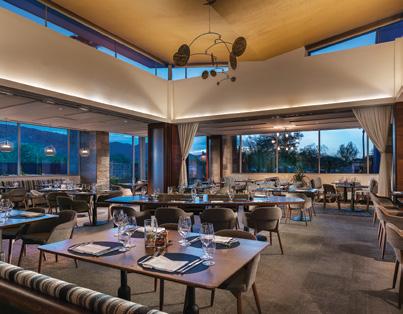


When it’s time to sleep, the hotel features 183 guest rooms along with 37 condos and suites in a luxury wing. The rooms here are comfortable, quietly luxurious and contempo rary. Rooms feature either patios or balconies. Guests can look forward to mostly gray tones with striking blue chairs throughout the rooms. Some highlights include the Immerse Guest rooms, which feature a that gives the bather a chance to take in views of Camelback Moun tain but is tucked away in a corner for privacy. Some of the most lavish accommodations in clude the Penthouse South. This 3,410-squarefoot penthouse features three bedrooms, a full kitchen, a butler pantry and a cinema room. One of the penthouse’s most remarkable attrac tions is its five private decks where guests can take in mountain views.





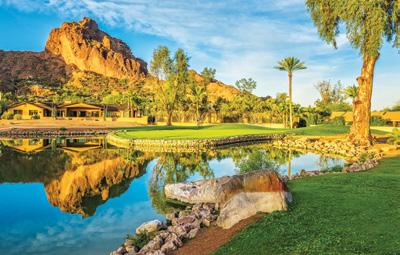
Mountain Shadows is home to The Short Course, an 18-hole golf course that totals 34 acres where golfers can take in those scenic mountain views. Like the hotel itself, the golf course is historic and first opened in 1961. Each hole is par 3. Forrest Richardson is the golf course architect, and he has a fascinat ing tie to the resort’s long history. Richardson actually worked for the golf course’s original architect, Jack Snyder. Some of the featured holes include number 7 or “Jutty,” a short hole that’s located across the water along the famous Mountain Shadows pond and the number 10 or the “Punchbowl,” a pocketed green that offers up great views of Camelback Mountain’s camel head. Rental clubs are com plimentary for resort guests and cost $49.99 per club rental. Guests also can book lessons at the golf shop. The golf course has its own restaurant, Rusty’s at the Short Course. Guests can dig into hearty fare like the PV breakfast burrito, signature dry rubbed chicken wings, a chicken Caesar wrap and a pastrami Reu ben, pastrami, gruyere cheese, sauerkraut and thousand island dressing in between slices of marble rye. This tasty sandwich that somehow manages to be both light and hearty at once is beloved amongst the golfers, according to Chef Wiley.


One of the newer hotel offerings is the adults only Sunset Pool. Tucked away in the western part of the resort and just a few steps from Rusty’s, the pool manages to feel like its own private oasis. The long and curved pool serves up iconic views of Cam elback Mountain. It offers a quieter setting than the resort’s main pools. After taking a dip in the pool, guests can book a Sunset Premium Daybed with an umbrella from 10 a.m. to 5 p.m. They can enjoy a fruit plate or chips and guacamole and a choice of one bottle of rose, six domestic beers and six White Claw seltzers.
Those with guestroom, cabana or daybed reser vations can enjoy tunes from a DJ every Saturday from 1 to 4 p.m. The resort is hosting yoga on Fri day nights at 6:30 p.m., an indoor morning medita tion at 9 a.m. on Saturdays and sound healing on Sundays at 10 a.m. These are free for guests. One Saturday a month, guests can embark on a Brunch & Learn experience where a chef will do a demo while
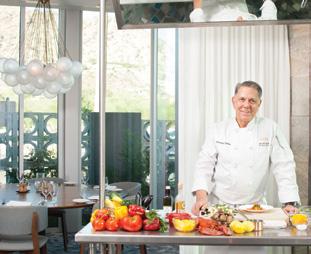
guests enjoy brunch with a paired wine and take home a recipe. One Saturday a month, guests can partake in Learning & Libations where they enjoy light bites and a tasting seminar along with a history lesson from one of the hotel’s beverage experts.
Given its contemporary luxury, prime location and stellar programming, Mountain Shadows has proven that it’s one of the area’s top resorts and adds a modern touch to an area that lacked it.


STORY BY TONY DEAN
Few resorts embody both legend and liveliness quite like the histor ic Hotel del Coronado. Since opening in 1888, “The Del” has welcomed presidents, Hollywood royalty, and generations of travelers seeking the magic of Southern California’s coast. Today, following the completion of a more than $550 million restoration of its iconic Victorian building, the hotel feels both timeless and newly reborn—its grandeur preserved for genera tions to come.
Yet amid the sweeping history and fresh polish, it’s often the
simplest pleasures that linger most. In the evenings, the central lawn transforms into something extraordinary. After dinner, as twilight falls over the red tiled rooftops, the open green comes alive with music, laughter, and community. Families gather, children dart across the grass, and couples linger with ice cream or a glass of wine in hand. It feels less like a luxury resort and more like a neighborhood gathering—intimate, relaxed, and ir resistibly welcoming.
This nightly ritual captures The Del’s essence: a place where legacy meets life, where the elegance of history is matched
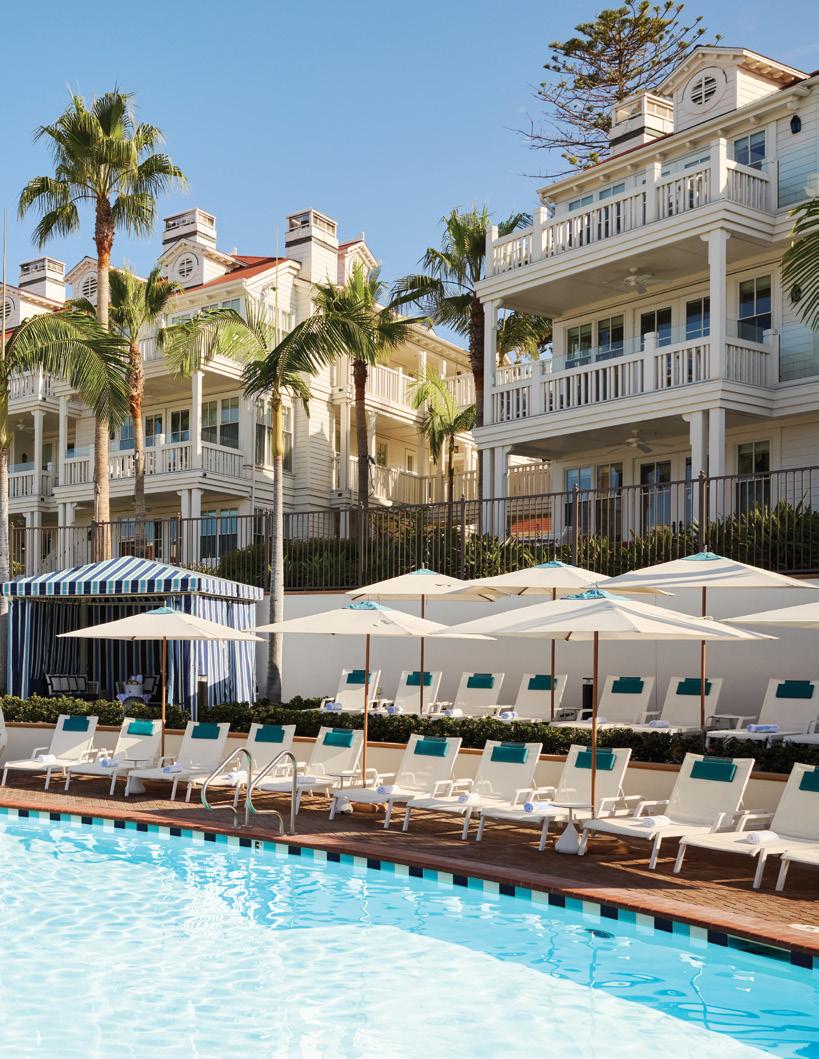
by the joy of togetherness. For all the grandeur, it’s here—under the stars, surrounded by strangers who feel like friends—that you find the hotel’s true magic.
It’s the kind of experience you can’t wait to relive.



Every so often, a putter crosses my desk that demands more than just a roll across the practice green—it demands a conversation. The new PXG Battle Ready II Torpedo is one of those rare breeds. Not just another high MOI mallet in a crowded field, this putter brings personal ity to performance and precision to preference.
Let’s start with the bones. The Torpedo is crafted with a hollow bodied 303 milled stainless steel chassis wrapped around PXG’s S COR™ polymer core. Translation? You get a stout, confident head that feels like forged steel in the hands, yet responds like something far more forgiving at impact. The face is a whisper thin 0.055 inches, and with PXG’s third gen eration Pyramid Face Pattern, it grips dimples like a pro. Feedback is a soft “click” that’s more velvet than velvet rope.
Where the Torpedo truly separates itself is in customization. Hosel options? Plenty: Heel Shafted, Plumber’s Neck, Double Bend, even Armlock—for those who like to anchor without calling it that. PXG’s Precision Weighting Tech allows you to dial in balance and launch char acteristics to address that slight push you’ve been denying for months. Tinker if you must, or trust the stock setup. Either way, it delivers.
Aesthetically, the Torpedo is restrained— bold sightline, arrow straight alignment geom etry, and a compact mallet profile that doesn’t scream for attention but commands it. It’s one of those rare designs that flatters both the eye and the ego. Professionals trust it, but it doesn’t require a tour card to appreciate.
Performance wise, the Torpedo is stable through the stroke, with just enough feedback to remind you who’s in control. Heel to toe mishits? Barely noticeable. The ball rolls tight and true, and you don’t have to overstroke to get it there. There’s something innately satisfy ing about watching a 10 footer stay on track as if it’s being led by invisible rails.
In sum, the PXG Battle Ready II Torpedo doesn’t reinvent the putter—but it refines the entire experience. It’s a classic profile with mod ern muscle, tailored to the golfer who knows what he wants—and refuses to compromise. If you’ve been waiting for a mallet that feels like a blade but forgives like your best friend, give the Torpedo a go.
It might just earn a permanent spot in your bag.





STORY BY: BUCK MAYERS
If you can skip a rock on the lake, lop dandelions from a meadow with a cycle, swing a bat, throw a ball or swing a racket, you can swing a golf club well enough to play golf. The problem with much of the learning and instructional process is we all have a tendency to over think, over do and over emphasize mechanics and positions of the golf swing. If you’re trying to consciously put the club in all those “perfect” positions, you will experience paralysis by analysis.
The majority of golfers strive to just hit it solid, up in the air and relatively close to the target. A small percentage of players can hit it a certain height and distance and curve it at will consistently. Let’s imagine for a second the skipping of the rock. Did you think about shifting your weight back, turning your shoul ders, cocking your wrist, folding your elbow, stepping toward the lake, unwinding your hips, dropping your arm, snapping your wrist and turn your body at the target all in a balanced finish. If you did, the rock sunk to the bottom just like your golf swing will do if you think too much.
We all instinctively know how to propel an object in the most efficient way possible. When filming my students throwing a club at the target without preconceived ideas of right and wrong, they inevitably make a correct mo tion. Then I’ll film them hit ting a ball and disaster strikes. All of a sud
den, the ball becomes the target versus the flag. While looking and comparing the two vastly different swings on video, there is one glaring divergence. When throw ing the club, the eyes look toward the target much sooner. When hitting the ball, the focus was on the ball. As the video shows, the mind, body and club re spond to the target.
The breakthrough or revelation is this – practice more by removing the ball and the results of a shot un til you can repeat from a “new” point of view.
Therefore, instincts (with trust) change naturally. There is no question that the squareness of the club face, the path of the club, the angle it approaches, speed and hitting it solid are all important. The de tailed process of piecing together all of those analytical positions takes a lot of time, can be erratic and may or may not produce good results. Find your best swing with instinctive knowledge.

Buck Mayers is the Director of Instruction at Escondido Golf & Lake Club in Horseshoe Bay, TX and can be reached at buckmayersgolf.com.
STORY BY CYNTHIA REESE
If summer belongs to rosé, fall is undeni ably Pinot Noir’s season. Elegant, expressive, and endlessly versatile, Pinot is the red that bridges warm days and cool nights, light fare and hearty feasts. It’s a wine that feels like autumn in a glass.
Pinot Noir has long been celebrated for its finesse—vivid cherry and berry notes lay ered with spice, earth, and subtle floral un dertones. Unlike heavier reds, Pinot’s silky texture and balanced acidity make it an ideal partner for fall cuisine: roast chicken, wild mushroom risotto, pork tenderloin, or even Thanksgiving turkey. Few wines can move so seamlessly from casual dinner to five-course tasting menu.
forest-floor character. Sonoma Coast brings a touch of California sunshine—lush fruit framed by elegance. Even emerging regions, from New Zealand to Chile, are carving out distinctive Pinot styles that rival the classics.
And while Pinot often carries an air of re finement, its approachability is what makes it so beloved. A great bottle can impress a som melier yet still feel inviting at a family din ner table. It’s a wine that connects people— elevating meals, sparking conversations, and adding a layer of warmth to gatherings.

Global in scope yet deeply tied to place, Pinot shines in some of the world’s most ro mantic regions. Burgundy remains the benchmark, with wines that are as complex as they are timeless. Ore gon’s Willamette Valley offers vibrant, cooler climate ex pressions with cranberry and

For luxury travelers, Pinot is more than a bottle—it’s a passport. Vineyard stays in Bur gundy, harvest festivals in Oregon, or chef led wine dinners in Sonoma allow aficionados to immerse themselves in the story of the grape. Increasingly, estates are curating experienc es that go beyond the tasting room—truffle hunts, art pairings, and private blending ses sions—each adding dimension to Pinot’s mys tique.
This fall, as the leaves change and the menus grow richer, Pinot Noir stands ready. It’s not just a wine; it’s a season’s signature. Subtle yet profound, approachable yet sophis ticated, Pinot is proof that sometimes the most graceful things are also the most powerful.


There’s something about the rhythm of golf that invites the slow burn of a good cigar. It’s not rushed. It’s not loud. It’s personal, with space to think, relax, and reconnect with friends—or with yourself.
A good cigar on the course doesn’t just fill time between shots—it enhances the experience. You’re already surrounded by wide open fairways, sun splashed greens, and maybe even the sound of distant sprinklers or a breeze cutting across a canyon wall. A well chosen cigar fits right into that mood.
So what smokes make sense under the sun? Keep it medium. You want something flavorful but not overwhelming—nothing that takes over your senses or leaves you fighting the back nine with a head full of nicotine. Try a Padron 2000 Natural for smooth richness or an Arturo Fuente Hemingway Short Sto ry for a compact, manageable option that won’t go out if your swing heats up.
Of course, no cigar ritual is complete without
gear. A portable humidor that fits in the side pocket of your golf bag is worth the investment, especially in the Texas or Vegas heat. Look for a windproof torch lighter and a clip that can mount your cigar safely to the cart while you line up a shot. You want convenience, not chaos.
Timing matters, too. Some light up as soon as they hit the second hole, while others wait for the back nine to slow things down. There’s also the time honored tradition of the 19th hole smoke—sa voring a victory or letting the day melt into a mel low finish.
Just remember, golf is a shared space. A cigar should elevate the day for everyone. Keep the smoke away from others who aren’t part of the ritual, ash responsibly, and never let a relight delay the group.
Cigars and golf—two classics built on tradition, pace, and presence. When done right, they make a round more than a game. They turn it into a memory.

